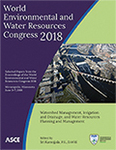World Environmental and Water Resources Congress 2018
Network Effects of Evolving Water Demand Patterns
Publication: World Environmental and Water Resources Congress 2018: Watershed Management, Irrigation and Drainage, and Water Resources Planning and Management
ABSTRACT
Water demand management strategies, such as more efficient end-use technology, alternative water resources, and demand response policies have shown promise in reducing consumption and shifting peak demands. Improving demand estimation through smart metering, as well as the potential savings from implementing various demand management strategies on the household, regional, and national scales, have been studied in literature. However, there is a lack of research on how these evolving water demand patterns affect the performance of water distribution networks on a network-wide scale. In this study, three residential demand patterns were used: 1) standard diurnal, 2) flattened demand, representing the response to economic incentives or technological mechanisms, and 3) reduced demand, which models the response to efficient end-use technology and alternative water sources. The network dynamics associated with the three scenarios were investigated using a hydraulic simulator. Four metrics are suggested to assess the network-wide performance in each scenario: water loss, peak flow, water age, and energy loss. Results from simulations using a real-world network indicated that decreased consumption and variance in demand had a negative or negligible impact on water loss and age, but there is a potential for savings in terms of reduced energy losses. The results highlight the implications on water management and planning from the network infrastructure and utility side.
Get full access to this chapter
View all available purchase options and get full access to this chapter.
REFERENCES
AWWA (1989). AWWA Manual M32-Distribution Network Analysis for Water Utilities. American Water Works Association, Denver, CO.
Beal, C. D. and Stewart, R. A. (2014). “Identifying residential water end uses underpinning peak day and peak hour demand.” Journal of Water Resources Planning and Management, 140(7), 04014008.
Cominola, A., Giuliani, M., Piga, D., Castelletti, A., and Rizzoli, A. (2015). “Benefits and challenges of using smart meters for advancing residential water demand modeling and management: A review.” Environmental Modelling and Software, 72, 198–214.
Creaco, E., Blokker, M., and Buchberger, S. (2017). “Models for generating household water demand pulses: Literature review and comparison.” Journal of Water Resources Planning and Management, 143(6), 04017013.
EPA (2002). “Effects of water age on distribution system water quality.” Distribution system issue paper, US Environmental Protection Agency.
Giustolisi, O., Savic, D., and Kapelan, Z. (2008). “Pressure-driven demand and leakage simulation for water distribution networks.” Journal of Hydraulic Engineering, 134(5), 626–635.
Gurung, T., Stewart, R., Beal, C., and Sharma, A. (2016). “Smart meter enabled informatics for economically efficient diversified water supply infrastructure planning.” Journal of Cleaner Production, 135, 1023–1033.
Gurung, T., Stewart, R. A., Beal, C. D., and Sharma, A. K. (2015). “Smart meter enabled water end-use demand data: platform for the enhanced infrastructure planning of contemporary urban water supply networks.” Journal of Cleaner Production, 87, 642 – 654.
Jolly, M., Lothes, A., Bryson, L., and Ormsbee, L. (2014). “Research database of water distribution system models.” Journal of Water Resources Planning and Management, 140(4), 410–416.
Lambert, A. (2001). “What do we know about pressure: Leakage relationships in distribution systems?” Proc. IWA System Approach to Leakage Control and Water Distribution Systems Management (January).
Maggioni, E. (2015). “Water demand management in times of drought: What matters for water conservation.” Water Resources Research, 51, 125–139.
Malinowski, P. A., Stillwell, A. S., Wu, J. S., and Schwarz, P. M. (2015). “Energy-water nexus: Potential energy savings and implications for sustainable integrated water management in urban areas from rainwater harvesting and gray-water reuse.” Journal of Water Resources Planning and Management, 141(12), A4015003.
May, J. (1994). “Pressure dependent leakage.” World Water Environmental Engineering Management.
Olmstead, S. and Stavins, R. (2007). “Managing water demand: price vs. non-price conservation programs.” White Paper 39, Pioneer Institute.
Rossman, L. (2000). EPANET 2 Users Manual. US Environmental Protection Agency, Cincinnati, OH. EPA 600-R-00-05.
Sitzenfrei, R., Zischg, J., Sitzmann, M., Rathnayaka, S., Kodikara, J., and Bach, P. (2017). “Effects of implementing decentralized water supply systems in existing centralized systems.” World Environmental and Water Resources Congress 2017, ASCE, 692–702.
Information & Authors
Information
Published In
World Environmental and Water Resources Congress 2018: Watershed Management, Irrigation and Drainage, and Water Resources Planning and Management
Pages: 93 - 104
Editor: Sri Kamojjala, Las Vegas Valley Water District
ISBN (Online): 978-0-7844-8140-0
Copyright
© 2018 American Society of Civil Engineers.
History
Published online: May 31, 2018
Authors
Metrics & Citations
Metrics
Citations
Download citation
If you have the appropriate software installed, you can download article citation data to the citation manager of your choice. Simply select your manager software from the list below and click Download.
